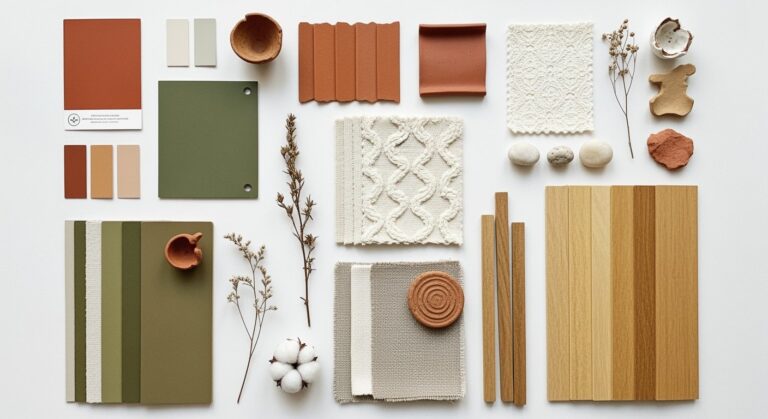Finding the right color palette for a rustic home is a special kind of challenge.
It’s not about chasing trends or making a loud statement.
It’s about a feeling.
A sense of belonging to the landscape around it.
Of being solid, honest, and warm.
What Makes a Palette Rustic?
So what does “rustic” even mean when it comes to color?
It’s a palette pulled directly from the natural world.
Think earth, stone, and timber.
These colors feel grounded. They have a certain weight to them.
There’s nothing synthetic or temporary about them.
They’ve been around forever. And they’ll be around for a lot longer.
This isn’t the place for bright, saturated hues.
Everything is a bit muted, a bit weathered.
Like a photograph that’s been faded by the sun.
Earthy and Natural Tones
The foundation of any rustic palette is earth tones.
Deep, rich browns are a given.
They echo the look of stained wood, of tree bark, of fertile soil.
Think of a dark walnut or a weathered oak.
These colors bring an instant sense of warmth and history.
Then you have the grays and charcoals.
Not cold, industrial grays.
But the soft, complex grays of river stones or a stormy sky.
These colors are perfect for exterior siding or a rugged stone facade.
They provide a beautiful, grounding contrast to the warmer browns.
Greens also play a crucial role.
But not just any green.
We’re talking about muted, earthy greens.
Sage, moss, and olive.
Colors you’d find on a walk through the woods.
They connect the home directly to its surroundings, whether it’s nestled in a forest or sitting on an open field.
It’s about creating a seamless transition from the built world to the natural one.
Looks great. Feels right.
Adding Contrast with Creams and Whites
A rustic home doesn’t have to be all dark and heavy.
In fact, it shouldn’t be.
You need moments of lightness to balance things out.
That’s where creams and off-whites come in.
A crisp, brilliant white can feel a bit too stark in a rustic setting.
It can look jarring against all those natural, weathered tones.
But a soft, creamy white is a different story.
Think of the color of linen, of sheep’s wool.
It’s a white with a bit of warmth in it.
This is the perfect color for trim, for window frames, for a welcoming front door.
It provides a clean, crisp edge without feeling out of place.
It’s clean. It’s modern. It works.
A Touch of Muted Color
While the core of a rustic palette is neutral, that doesn’t mean there’s no room for color.
But the key is to keep it muted.
Desaturated.
A barn-inspired red can look fantastic on an exterior door or shutters.
It’s a classic for a reason.
It’s bold, but in a way that feels timeless, not trendy.
And it connects to a long history of rural architecture.
A dusty, faded blue can also be a beautiful accent.
The color of a twilight sky or a distant mountain range.
It’s calming and serene.
And it pairs beautifully with both the warm browns and the cool grays of a rustic palette.
Not ideal for the main body of the house. But perfect for those smaller details.
When Materials Make the Difference
Of course, with a rustic home, the color palette isn’t just about the paint.
The materials themselves are a huge part of the equation.
The rich, varied tones of natural stone.
The warm grain of cedar or redwood.
The rugged texture of board and batten siding.
These materials bring their own colors and textures to the mix.
And the best rustic palettes are the ones that honor them.
You don’t want to fight against the natural beauty of the wood or stone.
You want to complement it.
A dark stain on a timber frame can bring out the richness of the wood grain.
A soft gray paint on the siding can make the stone foundation feel even more solid and grounded.
It’s all about working with what’s already there.
And letting the natural beauty of the materials shine through.
Ultimately, choosing a color palette for a rustic home is an intuitive process.
It’s about creating a home that feels like it belongs.
That feels like it’s been there for a long time.
And will be there for many years to come.

